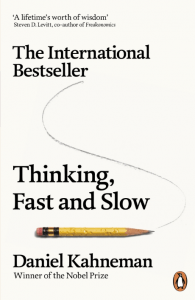Review Thinking, Fast and Slow
by DANIEL KAHNEMAN
Description
Author Daniel Kahneman’s bestselling “Thinking, Fast and Slow” expounds upon the workings of human psychology and how it can directly affect market trends and finances on a larger scale. In this book, Kahneman sheds light on the two major thinking systems (that he terms as ‘fast’ and ‘slow’) that govern behavior and thought patterns. From here, he proves how these two systems are what lead many traders to make costly yet easily-avoidable mistakes. “Thinking, Fast and Slow” is a fascinating insight into the mind of a trader and is guaranteed to provide information that would benefit the reader with a confidence that will enable them to make better decisions when trading.
About the Author
Daniel Kahneman is an Israeli-American psychologist notable for his work on the psychology of judgment and decision-making, as well as behavioral economics, for which he was awarded the 2002 Nobel Memorial Prize in Economic Sciences (shared with Vernon L. Smith). His empirical findings challenge the assumption of human rationality prevailing in modern economic theory. With Amos Tversky and others, Kahneman established a cognitive basis for common human errors that arise from heuristics and biases (Kahneman & Tversky, 1973; Kahneman, Slovic & Tversky, 1982; Tversky & Kahneman, 1974), and developed prospect theory (Kahneman & Tversky, 1979).
In 2011, he was named by Foreign Policy magazine to its list of top global thinkers. In the same year, his book Thinking, Fast and Slow, which summarizes much of his research, was published and became a best seller. He is professor emeritus of psychology and public affairs at Princeton University’s Woodrow Wilson School. Kahneman is a founding partner of TGG Group, a business and philanthropy consulting company. He is married to Royal Society Fellow Anne Treisman.
In 2015 The Economist listed him as the seventh most influential economist in the world.
Table of Contents
- Pt. 1. Two systems. The characters of the story
- Attention and effort
- The lazy controller
- The associative machine
- Cognitive ease
- Norms, surprises, and causes
- A machine for jumping to conclusions
- How judgments happen
- Answering an easier question.
- Pt. 2. Heuristics and biases. The law of small numbers
- Anchors
- The science of availability
- Availability, emotion, and risk
- Tom W’s specialty
- Linda : less is more
- Causes trump statistics
- Regression to the mean
- Taming intuitive predictions.
- Pt. 3. Overconfidence. The illusion of understanding
- The illusion of validity
- Intuitions vs. formulas
- Expert intuition : when can we trust it?
- The outside view
- The engine of capitalism.
- Pt. 4. Choices. Bernoulli’s errors
- Prospect theory
- The endowment effect
- Bad events
- The fourfold pattern
- Rare events
- Risk policies
- Keeping score
- Reversals
- Frames and reality.
- Pt. 5. Two selves. Two selves
- Life as a story
- Experienced well-being
- Thinking about life.
